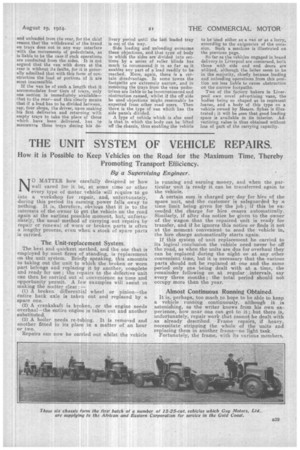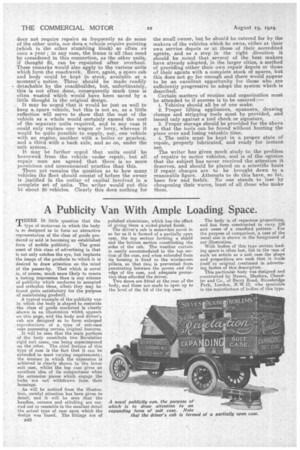THE UNIT SYSTEM OF VEHICLE REPAIRS.
Page 21

Page 22

If you've noticed an error in this article please click here to report it so we can fix it.
How it is Possible to Keep Vehicles on the Road for the Maximum Time, Thereby Promoting Transport Efficiency. By a Supervising Engineer.
N0 MATTER hoW carefully designed or how well cared for it be, at some time or other every type of motor vehicle will require to go into a workshop for repair, and, unlortueately, during this period its earning power falls away to nothing. It is, therefore, obvious that it is to the interests of the owner to get the vehicle on the road again at the earliest possible moment, but, unfortunately, the usual method of carrying out repairs by repair or renewal of worn or broken parts is often a lengthy process, even when a stock of spare parts is carried.
The Unit-replacement System'.
The best and quickest method, and the one that is employed by most firms of Standing, is replacement on the unit system. Briefly speaking, this amounts to taking out the unit to Which the broken or worn part belongs and replacing it by another, complete and ready for use ; the repairs to the defective unit can then be carried out at convenience as time and opportunity permit. A few examples will assist in making the matter clear :— (1) A broken differential wheel or pinion—the entire back axle is taken out and replaced by a spare one.
(2) A crankshaft is broken, or the engine needs overhaul—the entire engine is taken out and another substituted.
(3) A boiler needs re-tubing. It is removed and another fitted in its place in a matter of an hour or two.
Repairs can now be carried out whilst the vehicle is running and earning money, and when the particular unit is ready it can be transferred again to the vehicle.
A certain sum is charged per day for hire of the spare unit, and the customer is safeguarded by a tune limit being given for the job ; if this be exceeded the charge for hire ceases automatically. Similarly, if after due notice be given to the owner of the wagon that the repaired unit is ready for transfer, and if he ignores this notice or finds it not at the moment convenient to send the vehicle in, the hire charge automatically starts again.
If this system of unit replacement be carried to its logical conclusion the vehicle need never be off the road, as when the units are due for overhaul they can be replaced during the night or at any other convenient time, but it is necessary that the various parts should not be replaced at one and the same period only one being dealt with at a time, the remainder following on at regular • intervals, say every three months ; the total period should not occupy more than the year.
Almost Continuous Running Obtained.
It is, perhaps, too much to hope to he able to keep a vehicle running continuously, although it is astonishing, as the writer knows from his own experience, how near one can get to it; but there is, unfortunately, repair work that cannot be dealt with as already described. Frame repairs, if heavy, necessitate stripping the whole of the units and replacing them in another frame—no light task.
Fortunately, the frame, with its various members. does not require repairs as frequently as do some of the other units, nor does a, vehicle require painting (which is the other stumbling block) so often as once a year ; in any case, the frame is all that need be considered in this connection, as the other units, if thought fit, can be repainted after overhaul. These remarks would also apply to the various units which form the coachwork. Here, again, a spare cab and body could be kept in stock, available at a moment's notice. These should be made readily detachable by the coachbuilder, but, unfortunately, this is not often done, consequently much time is often wasted which would have been saved by a little thought in the original design.
It may be urged that it would be just as well to keep a spare vehicle, but this is not so, as a little reflection will serve to show that the cost of the vehicle as a whole would certainly exceed the cost of the separate units required, and in any case it could only replace one wagon or lorry, whereas it would be quite possible to supply, say, one vehicle with an engine, another with a boiler or gearbox, and a third with a back axle, and so on, under the unit system.
It may be further urged that units could be borrowed from the vehicle under repair, but all repair men are agreed that there is no more pernicious and uneconomical practice than this.
There yet remains the question as to how many vehicles the fleet should consist of before the owner is Justified in the outlay of capital involved in a complete set of units. The writer would nut this 'at about 20 vehicles. Clearly this does nothing for
the small owner, but he should be catered for by the makers of the vehicles which he owns, either at their own service depots or at those of their accredited agents, and as a step in the right direction it should be noted that several of the hest makers have already adopted, in the larger cities, a method of providing either their own repair depots or those of their agents with a complete stock of spares, but this does not go far enough and there would appear to be an excellent opportunity for those who are sufficiently progressive to adopt the system which is described.
Certain matters of routine and organization must be attended to if success is to be assured 1. Vehicles should all be of one make.
2. Proper lifting appliances, spanners, drawing clamps and stripping tools must be provided, and issued only against a tool check or signature. 3. Proper storage should be provided for the above so that the tools can be found without hunting the place over and losing valuable time.
4. The units must be kept in a proper state of repair, properly lubricated, and ready for instant use.
The writer has given much study to the problem of repairs to motor vehicles, and is of the opinion that the subject has never received the attention it deserves, and should be placed on a scientific basis if repair charges are to be brought down to a reasonable figure. Attempts to do this have, so far, been few and feeble. No one stands to lose by cheapening their wares, least of all those who make them.






























